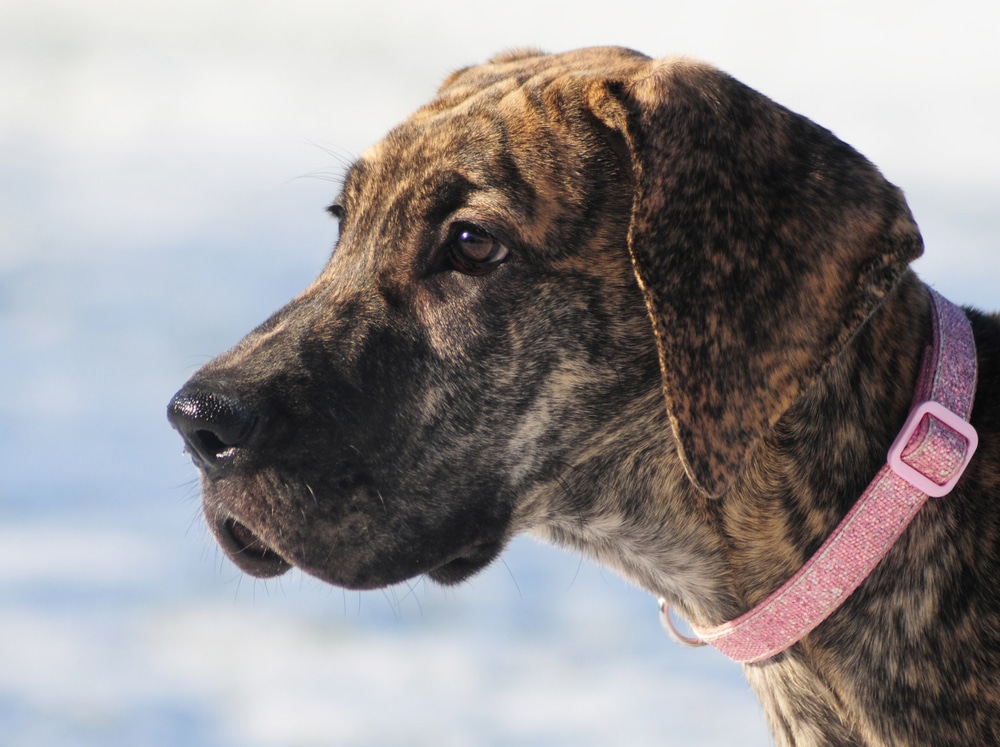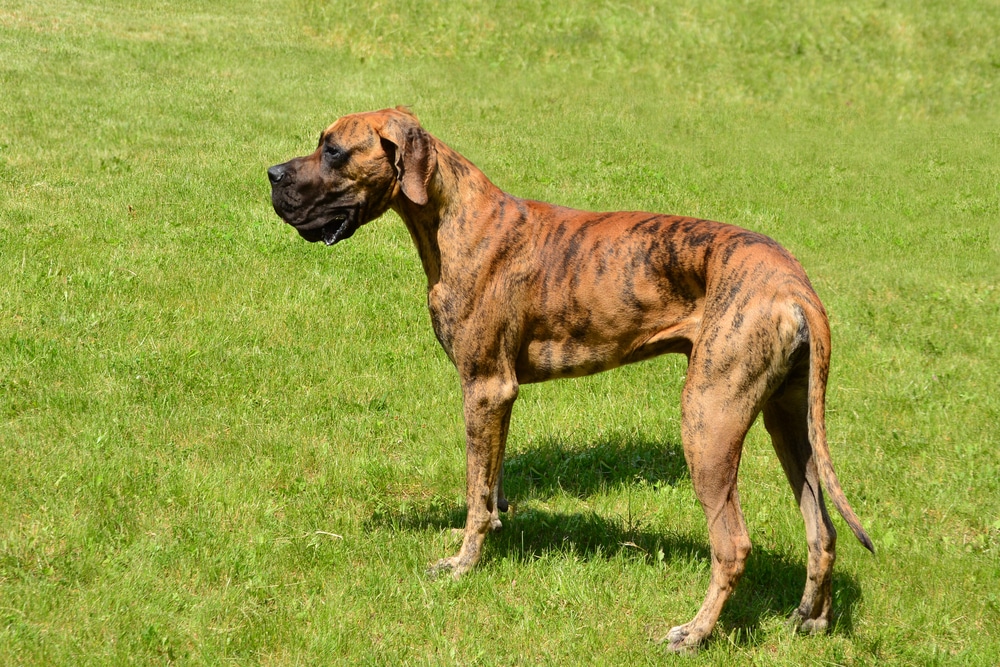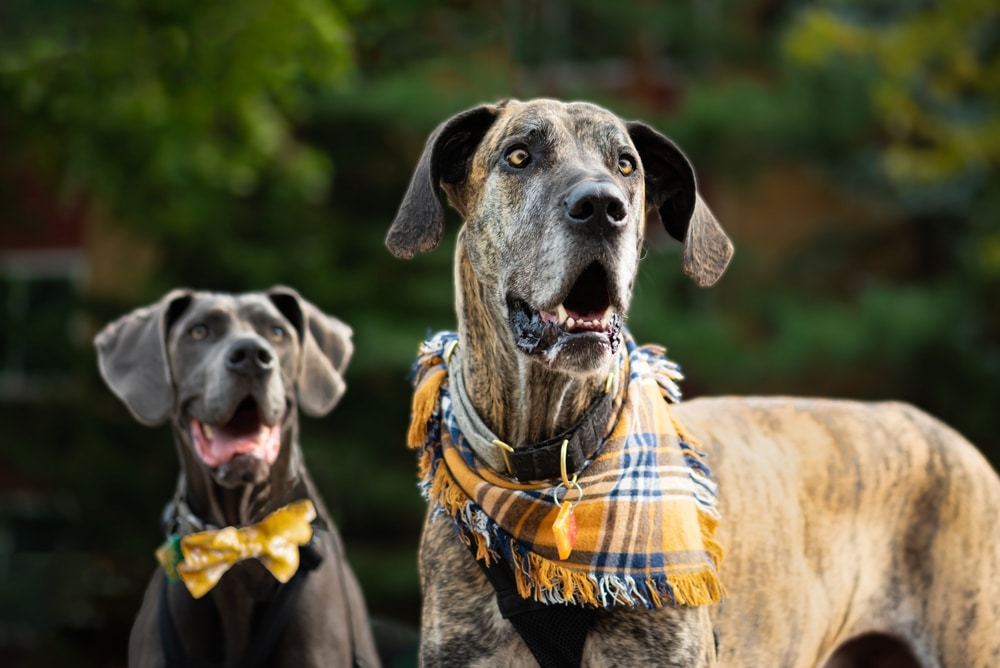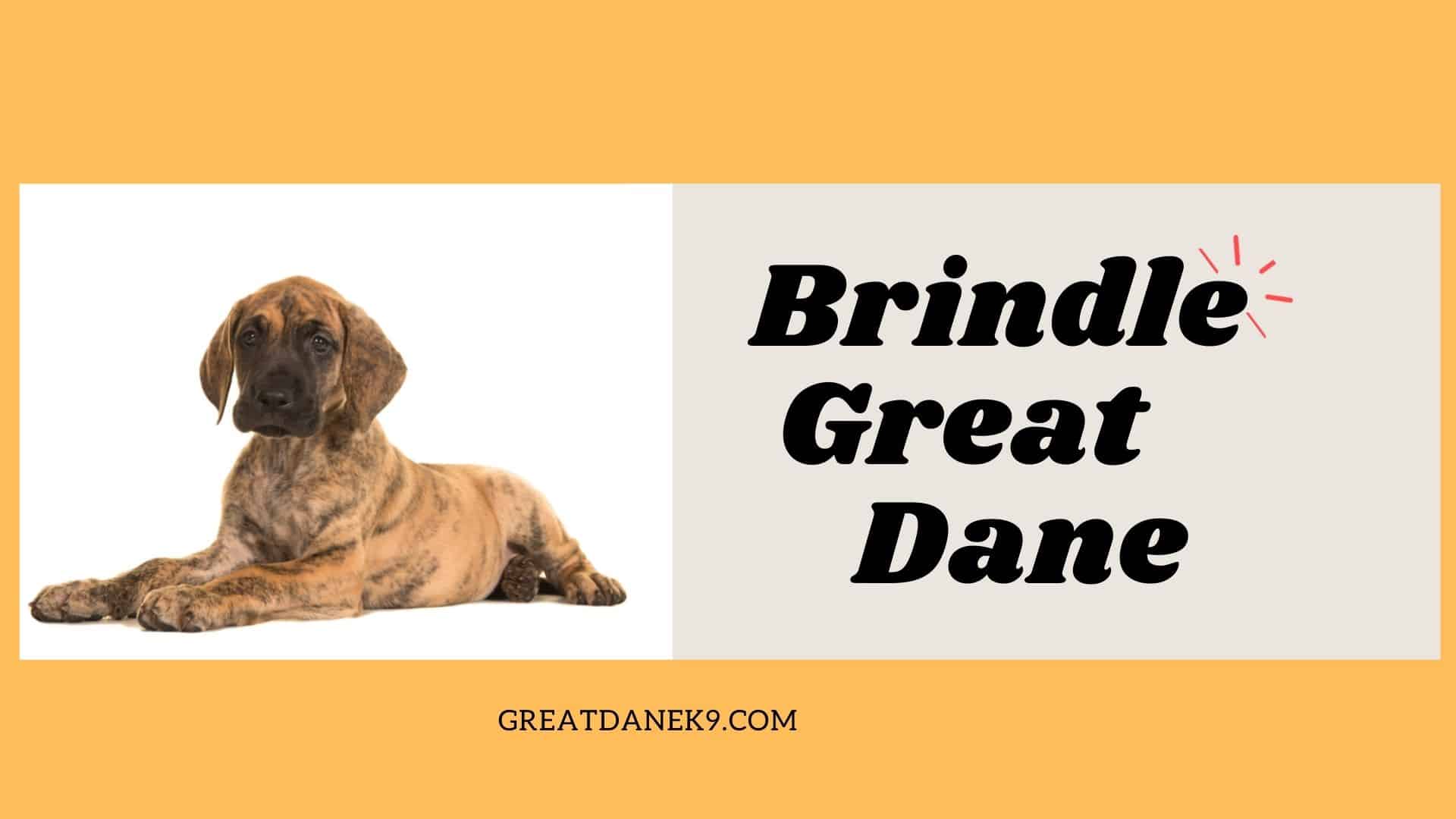“This post contains affiliate links, and I will be compensated if you make a purchase after clicking on my links.”
Last Updated on December 18, 2023
Brindle is one of the seven standard coat colors of the Great Dane. The Brindle coat is sometimes called “tiger-stripes” because the stripes are irregular and dark against a lighter base color. Although the coat pattern on a Brindle Great Dane is more subtle than that of a tiger’s coat.
In this article, we’ll help you understand what this unique coat is. Continue reading below to find out more!
Brindle Great Dane Appearance

The Brindle coat color is described as having a mixture of grey to black patterns on an attractive lighter base color. It is not an exclusive coat color to the Great Dane. And can also be seen in other dog breeds such as French Bulldogs, Greyhounds, Boxers, Bull Terriers and Akitas.
The Brindle Great Dane’s light base color, which is usually in different hues of yellow gold, include:
- Golden
- Fawn
- Golden brown
- Deep golden red
- Pale yellow
A Brindle Great Dane’s base coat color is “brindled” with dark-colored stripe markings all over their body. Usually, the base and stripe pattern colors include:
- Red and black
- Fawn and black
- Charcoal and grey
Size
A Brindle Great Dane holds a huge stature. It can grow up to 30 to 36 inches tall and can weight 120 to 200 lbs but stops growing after 2 years. So, the size your Brindle Great Dane exhibits at 20-24 months is the size of a fully grown Great Dane.
Of course, the growth pattern for every Great Dane is not the same. For instance, the American and European Great Danes growth patterns are different.
Brindle Great Danes according to AKC Standards
Did you know that there are standards for the Brindle Great Dane? According to the American Kennel Club (AKC), these are the standards of a Brindle Great Dane:
- The coat’s base color must be yellow gold and always be brindled with black cross stripes.
- Brindle shall have a black chevron pattern with a black mask. Black should appear on the eye rims and eyebrows and may appear on the ears and tail tip.
- The more intense the base color and the more distinct and evenly brindled, the more preferred will be the color.
- White markings on the chest or toes; black fronted; dirty colored Brindles; are not desirable
Let’s break these down into simpler terms and discuss them, shall we?
The first point is pretty self explanatory. The base color must always be yellow gold and the stripes must be black.
The second point indicates that the brindle should appear in a certain pattern. The black color should appear not only on the face or muzzle, but also around the eyes, eyebrows, ears and tail tips.
The third point talks about preference for Brindle Great Danes. The more distinct and evenly balanced the base color and stripes are, the better. That means, too much or too little brindles are both undesirable.
Finally, the last point explains that white markings on the toes and chest, black chests or dirty colored Brindle Great Danes are all considered undesirable according to the AKC standards.
Mismarked Brindle Great Danes
A Great Dane’s coat color is based off of two primary pigments: the black pigment (eumelanin) and the red pigment (pheomelanin).
Great Dane puppies, like any other puppy, get half of their DNA from their parents. And the various genes they inherit influence these pigments to produce different coat colors and patterns.
And that is why there are non-standard or mismarked Brindle Great Danes that do not align with the AKC standards. Although these Brindle Great Danes are not acknowledged by the aforementioned standards, they still make great life companions.

Below is a list of other types of this coat color:
1. Blue Brindle Great Dane
Blue Brindle Great Dane is considered a mismark. These Great Danes have a combination of the blue and brindle coat colors. The “blue” color is more of a gray, slate or silver color with a tinge of blue. They usually have a light Fawn base coat with blue stripes brindled across their bodies.
2. Fawn Brindle Great Dane
At times, the Brindle coat color presents itself in such a subtle manner that it appears as a Fawn color. For the Fawn Brindle Great Dane, the black hue of the stripes against the yellow gold base color are less intense that the Great Dane appears to only have a Fawn coat color.
3. Black Brindle Great Dane
As mentioned above, various genes influence the two primary pigments into producing different coat colors and patters. At times, when there is “too much” of the black pigment, a Brindle Great Dane appears to have black patches instead of stripes. This mismark is referred to as the Black Brindle Great Dane.
4. Brindle Merle Great Dane
As the name suggests, this Brindle mismark is called as such because it’s a combination of the Brindle and Merle coat color. This might not be a rare coat color, but is considered a unique one.
5. Reversed Brindle Great Dane
The Reversed Brindle Great Dane, also known as dark Brindle or Onyx Brindle is a unique coat color. It is where there is an abundance of the black pigment that the Great Dane appears to almost have a black coat. A Reversed Brindle Great Dane has the base color and stripe colors reversed – black base coat against light colored stripes.
Breeding
Breeding for Brindles, while not rare, can be challenging and unpredictable. Usually, breeders stick within the same coat color family and rarely crossover with another color of the same breed.
Breeding of two Brindle Great Danes can either produce Fawn or Brindle puppies. And when bred together repeatedly, the puppy litter’s colors will get darker and darker, with the stripes becoming less distinct.
To bring back the distinctness of the base color and the brindles, breeders occasionally breed the Brindle Great Danes with Fawn Great Danes. This is because Brindles and Fawns come in the same family color.
Furthermore, even when breeders breed a perfectly brindled Great Dane, there is no assurance that the puppies will inherit the same coat. However, if planned carefully, Brindle Great Dane breeding can still be accomplished.
Health

According to a research, a dog’s coat color has an influence to its overall health and lifespan. For example, the Merle Great Dane is susceptible to health issues such as eye and ear deformities due to its coat color.
Luckily, for Brindle Great Danes, their coat color isn’t associated with any particular health problem or disease. Although, non-standard Brindles, such as the Blue Brindle Great Dane, can be prone to color dilution alopecia (CDA), which is common in blue or fawn-colored Great Danes.
Lifespan
Great Danes are very popular for their extraordinary size, but they’re also known for their short lifespan. On average, a Great Dane has a lifespan of 6 to 10 years, with some rare cases reaching the ripe age of 12.
Their short lifespan is linked to the fact that the breed has a preexisting susceptibility to diseases and other health issues. However, since Brindle Great Danes’ coat color isn’t associated with any disease, a Brindle Great Dane might be able to live a little longer compared to other Great Dane with a different coat color.
Personality and Temperament
Great Danes aren’t called “gentle giants” for nothing! A Brindle Great Dane, like all other Great Danes, has an affectionate, social and loyal personality.
They like people a lot, whether it’s their family, children or strangers. And they can be very welcoming to visitors, but will not hesitate to fiercely defend you when they need to.
Furthermore, since Brindle Great Danes have a “people pleaser” attitude, they are generally easy to train.
Training
As the Brindle Great Dane puppy grows rapidly, training during the first few months is important. As mentioned above, Great Danes are relatively easy to train due to their desire to please people. Although, some would disagree and find Great Dane puppies stubborn learners.
Nevertheless, puppy training is important. Because it helps them develop good personality traits and social skills. For them to grow up as well-rounded dogs, they need to be exposed to different people and environments.
Furthermore, they need to learn good behavior through trainings such as obedience training, potty training and leash training from a young age.
Conclusion

The Brindle Great Dane, while not exclusive to the breed and not rare, is loved by many because of it’s uniqueness.
And in addition to their interesting coat color, Brindle Great Danes, whether they’re acknowledge by AKC standards or not, have everything you need in a life companion – affectionate, loyal, a great protector and good with children and strangers.

1 thought on “Brindle Great Dane 101: A Helpful Guide”